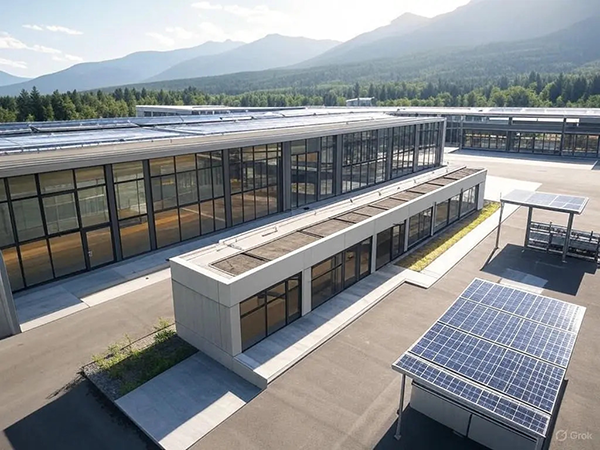Excitement surrounds the development of new data centres across Canada, presenting the country’s construction industry with the prospect of several major projects on the near-term horizon.
While the building of the centres themselves offers a great opportunity, there is an underlying additional benefit as well.
The new data centres will need massive amounts of power to both run the supercomputers and to cool them. In most cases, new electrical generation capability must be created along with expansion of the power distribution and grid infrastructure.
There are already about 240 data centres in Canada. According to Natural Resources Canada, together they consume annually about one per cent of the total electricity used in the country. However, the hunger for power is expected to grow significantly.
 SUBMITTED PHOTO — New data centres powered by renewable or solar power are favoured by companies like Bell Canada.
SUBMITTED PHOTO — New data centres powered by renewable or solar power are favoured by companies like Bell Canada.
The latest data centres consume much more power than their predecessors. The Royal Bank (RBC) says each ChatGPT query consumes 10 times more energy than a standard Google search. For advanced AI operations, such as generating text or images, requirements are exponentially higher. RBC projects if all 20 to 30 data centre projects currently being reviewed by regulators proceed, they will account for 14 per cent of Canada’s total power demand by 2030.
Building out for that demand could be a boon for Canadian construction. Hopefully, most of that new power will come from clean sources.
Canada’s electricity is low-cost and reliable. Approximately 85 per cent comes from renewable and non-emitting sources such as solar, hydro, nuclear and wind power.
British Columbia and Québec in particular are promoting this as a competitive advantage in their efforts to attract data centre investments. On the other hand, proposed data centres in Alberta will use existing natural gas power plants, although some renewable projects now in the planning stages may be added.
Among the names at the forefront of data centre development in this country are Canadian telecommunications giants Bell and Telus. Both are committed to clean power sourcing.
Bell’s plans are national in scope. Under the moniker Bell AI Fabric, the company has announced plans for a national network of six data facilities, initially focussed in the British Columbia interior and powered by hydroelectricity. One centre in Kamloops and a second in Merritt will be operating this year, with another four facilities planned. Bell will be looking at other regions of the country as well, based on an analysis of its corporate real estate holdings.
 SUBMITTED PHOTO — Telus will partner with Nvidia to expand their data centre in Rimouski, Que., taking advantage of the province’s low-cost hydroelectric power.
SUBMITTED PHOTO — Telus will partner with Nvidia to expand their data centre in Rimouski, Que., taking advantage of the province’s low-cost hydroelectric power.
Telus has partnered with Nvidia to upgrade its Rimouski, Que. facility with the ambition of creating a “Sovereign AI Factory” that will rely on hydroelectricity and natural cooling. A second facility is envisioned for Kamloops, B.C. as part of an overall $70 billion infrastructure upgrade to its services.“The Sovereign AI Factory will leverage TELUS’ high-speed, ultra-low-latency, fibre-optic network with sustainable data centres powered by 99 per cent renewable energy sources to deliver AI as a service,” the company said in a statement.
Telus says their data centre network will be many times more energy efficient than industry average, and will use significantly less electricity to power AI computing workloads. Reliance on natural cooling will cut water consumption by more than 75 per cent compared to traditional data centres, helping to make their Sovereign AI Factory one of the most sustainable AI-ready data centres in the world.
Beacon Data Centers is a new comer, tracing its origins to New York City investment firm Nadia Partners. Now head officed in Calgary, it has five data hubs in mind in various rural locations across Alberta. Three are already in queue for approval by the Alberta Electric System Operator. Power will be supplied by the provincial grid and likely some onsite generation, resulting in a mix of natural gas, solar and geothermal generation.
Even Canadian celebrity investor Kevin O’Leary has jumped onboard, announcing plans to develop a new high-powered data centre called Wonder Valley in northwest Alberta.
O’Leary intends to transform thousands of acres in the Municipal District of Greenview near Grande Prairie into, “the largest AI data centre industrial park in the world,” a commitment he estimates to be worth more than $70 billion. The Municipal District of Greenview will partner with O’Leary Ventures to develop the necessary “off-grid natural gas and geothermal” capacity to power the project.
Aside from the inclusion of fossil-fuelled power, Wonder Valley has also been criticized by the environmental group Clean 50 for its plan to, “drain watersheds spread across Treaty 8 territory belonging to the Metis Nation of Alberta Regions 4 through 6.”
It calls O’Leary’s “water guzzling data centre” ill-advised at a time when Greenview has coincidently declared a farm emergency due to drought conditions.
RBC estimates $100 billion in near-term capital expenditures is required for the recently-announced data centres and their accompanying power structure. This is very positive news for the Canadian construction industry. However, developing the centres in a clean, green manner is a goal that investors should consider as a priority.
John Bleasby is a freelance writer. Send comments and Climate and Construction column ideas to editor@dailycommercialnews.com.
